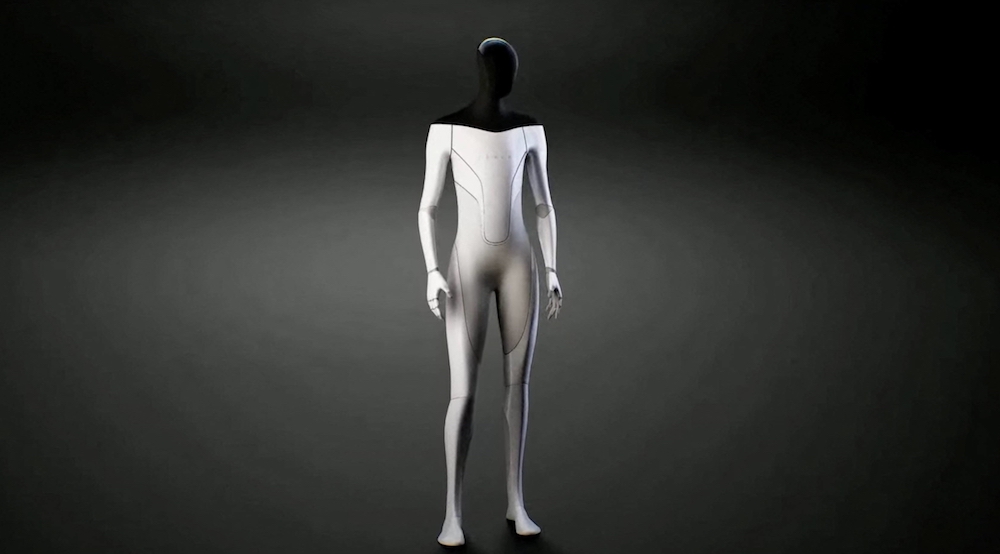Tesla’s Optimus robot: transformative or dystopian?

A rendering of Tesla’s humanoid, known as Tesla Bot or Optimus. | Credit: Tesla
As I write this, we are all eagerly and skeptically awaiting Elon Musk’s update on Tesla’s new Optimus robot. Musk said he will unveil a prototype of Optimus at Tesla’s AI Day on Friday.
Let’s be frank, Optimus feels a bit dystopian, as if we’re all going to be eminently replaced by a sleek, slender, cold electronic robot. It feels like Optimus inhabits a world of beautiful black and white design, while the rest of us get to drive around in stainless-steel Cybertrucks overseeing our hole-drilling operations on Mars.
Despite bold claims and billions of dollars of R&D investment across multiple companies, we simply don’t know when Level 5 self-driving cars will be a reality, let alone when we might have a humanoid robot matching anything close to human capabilities. Musk has shown us that landing a rocket on a boat in choppy seas is easier than reliably detecting stop lights. Massive amounts of R&D have gone into natural language understanding and seamless dialog creation, yet our conversations with voice assistants remain stubbornly transactional. The best a complex robot can do now is solve a Rubik’s cube with a jointed robotic hand.
The robotics landscape is changing quickly, though. Over 250 years passed between Da Vinci’s mechanical knight and the mechanically-driven textile mills that set off the industrial revolution. Almost 150 years later, we began to see electronic control beginning to fuse with mechanical control, from the pinsetter robotics that greatly improved the safety and speed of bowling, to mail sorters and printers that radically reduced the cost of paper-based communication. In just a matter of decades, software-driven automation and integration began to close the loop between stand-alone mechatronics and entirely autonomous systems from your Roomba to Amazon’s robotics-enabled warehouses. And now we’re seeing the fusion of computer vision and ML-driven planning in picking robots and sidewalk bots.
The latest transformation is the emergence of multi-purpose collaborative robotics. These collaborative robotic building blocks can work alongside humans while being easily repurposed to new and adjacent use cases with little to no mechanistic changes, but rather through software and ML model changes. The most successful collaborative robot to date is the 6-degree-of-freedom robotic arm. The collaborative 6DOF arm is now used in fields ranging from automotive welding to loading and unloading pallets of goods to performing surgical procedures.
Today, we do not have enough truly multi-purpose collaborative robots. Drones are also emerging as a very general building block that can be repurposed for tasks ranging from search and rescue to inspection, to delivery, but has further to go to be truly collaborative. AMRs are fantastic, and Amazon has done outstanding work with their automated mobile robot, Proteus, but AMRs are not capable of being easily repurposed for new tasks.
At Collaborative Robotics, we are investing in a new type of collaborative robot. A robot that is easily repurposed to a wide range of logistics and material movement tasks. Not a humanoid, but a mobile collaborative robot. It’s less sci-fi and more trustworthy.
We’re excited about a future where collaborative robots will become increasingly capable and increasingly intelligent machines. Not dystopian human replacements, but trustworthy partners in a highly automated society. These future intelligent machines will be our autonomous taxis driving us from place to place. They will be our delivery agents bringing groceries to our door or even into our kitchen. They will be home assistants capable of collecting the linens, folding laundry, or tidying up a hotel room. They will be our voice assistants able to carry on a natural, multi-turn voice dialog seemingly effortlessly, and pack a grocery bag.
As for Telsa’s humanoid clone, as much as I admire the boldness of the vision, I very much expect the first robot we will see that feels truly intelligent will be the self-driving car. GPT-3 tells me they’re coming in 2040. I can’t wait.

About the Author
Brad Porter is CEO and founder of Collaborative Robotics, a robotics startup that is building the next generation of robots designed to solve a variety of indoor and outdoor tasks. Based on a flexible mobility platform, the robots will be capable of exploiting structures inside warehouses while also navigating and adapting to less structured outdoor environments.
Prior to founding Collaborative Robotics, Porter served as CTO of Scale AI and head of Amazon’s robotics division, where he was responsible for driving improvements in the safety and autonomy of Amazon’s world-wide operations.
The post Tesla’s Optimus robot: transformative or dystopian? appeared first on The Robot Report.
from The Robot Report - Robotics News, Analysis & Research https://ift.tt/LvbcBYk
via artificialconference

Comments
Post a Comment